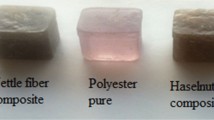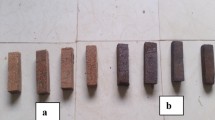Abstract
The objective of this work is to realize and characterize physically, thermally and mechanically hybrid particleboard made of raffia vinifera and Bambusa vulgaris. This realization used urea formaldehyde as a binder. Particles are obtained by grounding row materials by hammer mills and sieved to obtain three particle sizes. Two reinforcement rates were used to make particleboard by contact molding. Samples obtained are dried at room temperature for a week before submitted to tests. Apparent density and absorption rate were determined by gravimetric method. Value of density allows the particleboards obtained to be classified as light materials. Values of water absorption rate show that the particleboards do not absorb as much water as each material taken separately. Asymmetric hot plane method was used to determine the thermal effusivity and conductivity of the particleboards. Values obtained allow to say that the composite obtained can be classified among the insulating materials with a thermal conductivity lower than the unit. Young’s modulus of particleboards was determined by three-point bending test. Results show that the particleboards obtained are less rigid than the Bambusa vulgaris in its raw state. According to results, these materials can be used as insulation materials in the building and interior vehicles.











Similar content being viewed by others
References
Jacobson MZ (2009) Review of solutions to global warming, air pollution, and energy security. Energy Environ Sci 2(2):148–173. https://doi.org/10.1039/b809990c
Nordell B (2003) Thermal pollution causes global warming. Glob Planet Change 38(3–4):305–312. https://doi.org/10.1016/S0921-8181(03)00113-9
Zandalinas SI, Fritschi FB, Mittler R (2021) Global warming, climate change, and environmental pollution: recipe for a multifactorial stress combination disaster. Trends Plant Sci 26(6):588–599. https://doi.org/10.1016/j.tplants.2021.02.011
Njeugna E, Sikame TNR, Drean J, Fokwa D, Harzallah O (2012) Mechanical characterization of raffia fibres from ‘Raphia vinifera’. Int J Mech Struct 3(1):1–17
Erakhrumen AA, Ogunsanwo OY (2009) Water absorption, anti-swell efficiency, and dimensional stability properties of neem seed oil treated wild grown Bambus vulgaris schrad. Ex J. C. Wendl. in Southwest Nigeria. BioRessources 4(4):1417–1429
Mohmod AL (1993) Effects of age and height of three bamboo species on their machining properties. J Trop For Sci 5(4):528–535
Mohmod AL, Ariffin WTW, Ahmad F (1990) Anatomical features and mechanical properties of tree Malaysian bamboos. J Trop For Sci 2(3):227–234
Foadieng E, Talla PK, Fogue M (2019) Study of the mechanichal properties of raffia bamboo Vinifera L. Aracaceae. Rev Sci Tech For Environ du Bassin du Congo 12:12–21
Sikame TNR, Njeugna E, Fogue M, Drean JY, Fokwa D (2013) Study of water diffusion through raffia vinifera fibres of the stem from Bandjoun-Cameroon: case of drying kinetics. Res J Appl Sci Eng Technol 6(19):3547–3558
Fujiyama RT, Clay A (2020) Effect of chemical treatment and length of raffia fiber (Raphia vinifera) on mechanical stiffening of polyester composites. Polymers 12(12):2899. https://doi.org/10.3390/polym12122899
Hu Y, He M, Zhu R, Zhang Y, Yu Y, Yu W (2018) Influence of dyieng treatment on the performance of bamboo-based fibre composites. J Trop For Sci 28(2):112–120
Rassiah K, Ahmad MMHM (2013) A review on mechanical properties of bamboo fiber reinforced polymer composite. Aust J Basic Appl Sci 7(8):247–253
Thwe MM, Liao K (2002) Effects of environmental aging on the mechanical properties of bamboo–glass fiber reinforced polymer matrix hybrid composites. Compos Part A 33(1):43–52. https://doi.org/10.1016/S1359-835X(01)00071-9
Musset R (1933) Le raphia. Ann Georgr 42(236):190–193
Obahiagbon FI (2009) A review of the origin, morphology, cultivation, economic products, health and physiological implications of Raphia palm. Afr J Food Sci 3(13): 447–453 https://www.researchgate.net/publication/228366758 (Online)
Etuk SE, Akpabio LE, Akpabio KE (2003) Investigation of Raphia hookeri trunk as a potential ceiling material for passively cooled building design. Ghana J Sci 43(1):3–7. https://doi.org/10.4314/gjs.v43i1.15894
Sikame NRT, Njeugna E, Fogue M, Drean J-Y, Nzeukou A, Fokwa D (2014) Study of water absorption in raffia vinifera fibres from Bandjoun, Cameroon. Sci World J 2014:1–11. https://doi.org/10.1155/2014/912380
Elenga RG, Dirras GF, Goma Maniongui J, Djemia P, Biget MP (2009) On the microstructure and physical properties of untreated raffia textilis fiber. Compos A Appl Sci Manuf 40(4):418–422. https://doi.org/10.1016/j.compositesa.2009.01.001
Kankam CK (1997) Raffia palm-reinforced concrete beams. Mater Struct 30(5):313–316. https://doi.org/10.1007/BF02486356
Kaur PJ (2018) Bamboo availability and utilization potential as a building material. For Res Eng Int J 2(5):240–242. https://doi.org/10.15406/freij.2018.02.00056
Bahru T, Yulong D (2021) A review on bamboo resource in the African region: a call for. Int J For Res 2021:10–12
Bhalla R, Gupta S, Sudhakar S, Suresh P (2008) Bamboo as green alternative to concrete and steel for modern structures. J Environ Res Dev 3(2):362–370
Nurdiah EA (2016) The potential of bamboo as building material in organic shaped buildings. Procedia Soc Behav Sci 216:30–38. https://doi.org/10.1016/j.sbspro.2015.12.004
Escamilla EZ, Habert G, Daza JC, Archilla H, Fernández JE, Trujillo D (2018) Industrial or traditional bamboo construction? Comparative life cycle assessment (LCA) of bamboo-based buildings. Sustainability. https://doi.org/10.3390/su10093096
Nfornkah BN, Rene K, Louis Z, Martin T, Cedric CD (2020) Bamboo diversity and carbon stocks of dominant species in different agro-ecological zones in Cameroon. Afr J Environ Sci Technol 14(October):290–300. https://doi.org/10.5897/AJEST2020.2871
Shi SQ, Cai L, Weng Y, Wang D, Sun Y (2019) Comparative life-cycle assessment of water supply pipes made from bamboo vs. polyvinyl chloride. J Clean Prod 240:1–12
Chaowana P (2013) Bamboo: an alternative raw material for wood and wood-based composites. J Mater Sci Res. https://doi.org/10.5539/jmsr.v2n2p90
Papadopoulos AN, Hill CAS, Gkaraveli A, Ntalos GA, Karastergiou SP (2004) Bamboo chips (Bambusa vulgaris) as an alternative lignocellulosic raw material for particleboard manufacture. Holz als Roh - und Werkst 62(1):36–39. https://doi.org/10.1007/s00107-003-0447-9
Anokye R, Bakar SE, Ratnansingam J, Awang BK (2016) Bamboo properties and suitability as a replacement for wood. Pertanika J Sch Res Rev 2(1):63–79. https://doi.org/10.13140/RG.2.1.1939.3048
Nugroho N, Ando N (2001) Development of structural composite products made from bamboo II: fundamental properties of laminated bamboo lumber. J Wood Sci 47(3):237–242. https://doi.org/10.1007/BF01171228
Kazuya O, Toru F, Naoya Y (2005) Improvement of interfacial adhesion in bamboo polymer composite enhanced with micro-fibrillated cellulose. JSME Int J Ser A 48(4):199–204. https://doi.org/10.1299/jsmea.48.199
Okubo K, Fujii T, Yamamoto Y (2004) Development of bamboo-based polymer composites and their mechanical properties. Compos A Appl Sci Manuf 35(3):377–383. https://doi.org/10.1016/j.compositesa.2003.09.017
Verma CS, Sharma NK, Chariar VM, Maheshwari S, Hada MK (2014) Comparative study of mechanical properties of bamboo laminae and their laminates with woods and wood based composites. Compos B Eng 60:523–530. https://doi.org/10.1016/j.compositesb.2013.12.061
Liew FK, Hamdan S, Rahman MR, Rusop M (2017) Thermomechanical properties of jute/bamboo cellulose composite and its hybrid composites: the effects of treatment and fiber loading. Adv Mater Sci Eng 2017:1–10. https://doi.org/10.1155/2017/8630749
Okubo K, Fujii T, Thostenson ET (2009) Multi-scale hybrid biocomposite: processing and mechanical characterization of bamboo fiber reinforced PLA with microfibrillated cellulose. Compos A Appl Sci Manuf 40(4):469–475. https://doi.org/10.1016/j.compositesa.2009.01.012
Tripathi P, Yadav K (2017) Flexural & tensile strength of E-glass fiber/bamboo hybrid composite. Int Res J Eng Technol (IRJET) 4(5):2707–2709
Jawaid M, Abdul Khalil HPS (2011) Cellulosic/synthetic fibre reinforced polymer hybrid composites: a review. Carbohydr Polym 86(1):1–18. https://doi.org/10.1016/j.carbpol.2011.04.043
Kanitkar YM, Kulkarni AP, Wangikar KS (2017) Characterization of glass hybrid composite: a review. Mater Today Proc 4(9):9627–9630. https://doi.org/10.1016/j.matpr.2017.06.237
Ali NH, Shihab SK, Mohamed MT (2022) Mechanical and physical characteristics of hybrid particles/fibers-polymer composites: a review. Mater Today Proc. https://doi.org/10.1016/j.matpr.2022.02.614
Tiaya Mbou E, Njeugna E, Kemajou A, Tagne Sikame NR, Ndapeu D (2017) Modelling of the water absorption kinetics and determination of the water diffusion coefficient in the pith of raffia vinifera of Bandjoun, Cameroon. Adv Mater Sci Eng 2017:1–12. https://doi.org/10.1155/2017/1953087
Fokwa D, Ngapgue F, Mpessa M, Tamo Tatietse T (2012) Physical characterization of two cameroon bamboo species: Arundinaria alpina and Oxytenantera abyssinica. Int J Eng Technol 4(2):82–92
Damfeu JC, Meukam P, Jannot Y (2016) Modeling and estimation of the thermal properties of clusters aggregates for construction materials: the case of clusters aggregates of lateritic soil, sand and pouzzolan. Int J Heat Mass Transf 102:407–416. https://doi.org/10.1016/j.ijheatmasstransfer.2016.06.044
Revel GM (2007) Measurement of the apparent density of green ceramic tiles by a non-contact ultrasonic method. Exp Mech 47(5):637–648. https://doi.org/10.1007/s11340-006-9032-6
Afolabi TY, Agarry TJ, Tunde-Akintunde SE (2014) Modelling the water absorption characteristics of different maize (Zea Mays L.) types during soaking. Chem Process Eng Res 25:53–67
Cherki AB, Khabbazi A, Remy B, Baillis D (2013) Granular cork content dependence of thermal diffusivity, thermal conductivity and heat capacity of the composite material/granular cork bound with plaster. Energy Procedia 42:83–92. https://doi.org/10.1016/j.egypro.2013.11.008
Cherki AB, Remy B, Khabbazi A, Jannot Y, Baillis D (2014) Experimental thermal properties characterization of insulating cork–gypsum composite. Constr Build Mater 54:202–209. https://doi.org/10.1016/j.conbuildmat.2013.12.076
Wati E, Meukam P, Damfeu JC (2017) Modeling thermal performance of exterior walls retrofitted from insulation and modified laterite based bricks materials. Heat Mass Transf 53(12):3487–3499. https://doi.org/10.1007/s00231-017-2059-7
Osseni SOG, Apovo BD, Ahouannou C (2016) Caractérisation thermique des mortiers de ciment dopés en fibres de coco par la méthode du plan chaud asymétrique à une mesure de température. Afrique Sci 12(6):119–129
Maillet D, André S, Degiovanni A (1993) Les erreurs sur la diffusivité thermique mesurée par méthode flash: confrontation théorie-expérience. J Phys III 3(4):883–809. https://doi.org/10.1051/jp3:1993170
Faruk O, Bledzki AK, Fink HP, Sain M (2012) Biocomposites reinforced with natural fibers: 2000–2010. Prog Polym Sci 37(11):1552–1596. https://doi.org/10.1016/j.progpolymsci.2012.04.003
Alam DMN et al (2015) Properties of particleboard manufactured from commonly used bamboo (Bambusa vulgaris) wastes in Bangladesh. Adv Res 4(3):203–211. https://doi.org/10.9734/AIR/2015/15581
Khazaei J (2008) Water absorption characteristics of three wood varieties. Agron Res Mold XLI(2):5–16
Huisken MPW, Tchemou G, Rodrigue N, Tagne S, Ndapeu D, Njeugna E (2022) Effect of the addition of oil palm mesocarp fibers on the physical and mechanical properties of a polyester matrix composite. Int J Polym Sci. https://doi.org/10.1155/2022/3399986
FCBA (2008) Le guide des essences de bois
Adefisan OO, McDonald AG (2019) Evaluation of the strength, sorption and thermal properties of bamboo plastic composites. Maderas Cienc y Tecnol 21(1):3–14. https://doi.org/10.4067/S0718-221X2019005000101
Toguyeni DYK, Bathiebo JD, Koulidiati J (2011) Etude expérimentale, par la méthode du plan chaud, des propriétés thermophysiques d’un bois tropical et d’un panneau isolant formulé avec des intrants locaux. J Soc Ouest-Afr Chim 32:18–26
Damfeu JC, Meukam P, Jannot Y, Wati E (2017) Modelling and experimental determination of thermal properties of local wet building materials. Energy Build 135:109–118. https://doi.org/10.1016/j.enbuild.2016.11.022
Sikame Tagne NR, Mbou TE, Harzallah O, Ndapeu D, Huisken W, Nkemaja D, Njeugna E, Fogue M, Drean J-Y (2020) Physicochemical and mechanical characterization of raffia vinifera Pith. Adv Mater Sci Eng. https://doi.org/10.1155/2020/8895913
Bahari SA, Krause A (2016) Utilizing Malaysian bamboo for use in thermoplastic composites. J Clean Prod 110:16–24. https://doi.org/10.1016/J.JCLEPRO.2015.03.052
Agoua E, Allognon-houessou E, Adjovi E, Togbedji B (2013) Thermal conductivity of composites made of wastes of wood and expanded polystyrene. Constr Build Mater 41:557–562. https://doi.org/10.1016/j.conbuildmat.2012.12.016
Biswas S, Patnaik A, Kaundal R (2012) Effect of red mud and copper slag particles on physical and mechanical properties of bamboo-fiber-reinforced epoxy composites. Adv Mech Eng. https://doi.org/10.1155/2012/141248
Biswas D, Kanti S, Hossain MM (2011) International journal of adhesion & adhesives physical and mechanical properties of urea formaldehyde-bonded particleboard made from bamboo waste. Int J Adhes Adhes 31:84–87. https://doi.org/10.1016/j.ijadhadh.2010.11.006
Author information
Authors and Affiliations
Corresponding author
Additional information
Publisher's Note
Springer Nature remains neutral with regard to jurisdictional claims in published maps and institutional affiliations.
Rights and permissions
Springer Nature or its licensor (e.g. a society or other partner) holds exclusive rights to this article under a publishing agreement with the author(s) or other rightsholder(s); author self-archiving of the accepted manuscript version of this article is solely governed by the terms of such publishing agreement and applicable law.
About this article
Cite this article
Mbou Tiaya, E., Huisken Mejouyo, P.W., Ndema Ewane, P.A. et al. Effect of particle sizes on physical, thermal and mechanical behavior of a hybrid composite with polymer matrix with raffia vinifera cork and Bambusa vulgaris. Polym. Bull. 81, 275–295 (2024). https://doi.org/10.1007/s00289-023-04702-y
Received:
Revised:
Accepted:
Published:
Issue Date:
DOI: https://doi.org/10.1007/s00289-023-04702-y




